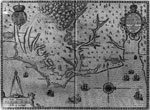In the wake of Columbus’ successes in the Caribbean, Spaniards became the first Europeans to explore the Atlantic and Gulf Coasts. Juan Ponce de León reached the continent in 1513 and named what he thought was an island “Florida.” He was fatally wounded during a second trip in 1521. Estevão Gomes, a Portuguese, sailing for Spain, reached Maine and the Canadian coast, and sighted Cape Cod in 1524.
In 1526 Lucas Vázquez de Ayllón founded the first settlement in the present-day United States at San Miguel de Gualdape, probably Sapelo Island, Georgia. Pánfilo de Nárvaez and his expedition disembarked at Tampa in 1526, explored the interior of Florida, sailed on to the coast of Texas, and died in a shipwreck with most of his men. Four survivors, led by Alvar Núñez Cabeza de Vaca, continued onward towards the west, eventually reaching Baja California.
Hernando de Soto in the 1540s and Pedro Menéndez de Avilés in the 1560s were important explorers and settlers in this area. Spaniards reached as far north as Chesapeake Bay by 1570 where Jesuit friars founded a mission in present-day Virginia.
1. Columbus made four voyages to the Caribbean. This 1493 letter describes the first voyage, made in 1492-93.
2. Early in the 16th century, Spaniards explored the Atlantic coast as far north as Virginia.
3. De Soto reached the Mississippi River in May 1541, an event that captured the imagination of Americans in the 19th century.
Epistola Christofori Colom...de insulis Indie supra Gangem nuper inve[n]tis...ad...D[omi]n[u]m Gabrielem Sanchis...Missa. [Letter of Christopher Columbus]. 1493. Rare Book and Special Collections Division. Library of Congress. (1)
[Map of the coast of Virginia in 1585]. Illus. in: Admiranda narratio, fida tamen, de commodis et incolarvm ritibvs Virginiæ … [America. Pt. 1]. Theodor de Bry. 1590. Rare Book and Special Collections Division. Library of Congress. (2)
The discoverer of the Mississippi. Print. Currier & Ives. 1876. Prints and Photographs Division. Library of Congress. (3)



